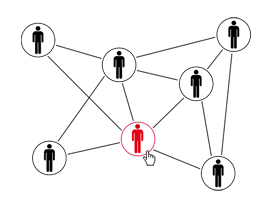Insights for Making Working at Home Work!
How can business and HR leaders manage challenges and find opportunities in the new realities of working at home?
(Note: join us on a webcast on how to work better work at home on Wednesday March 25 at ??? by registering at ???)
The global coronavirus has jolted the entire world. At a personal level, we are most concerned about health and safety, and we mourn with those who mourn for lost or isolated loved ones.
From this pandemic, new realities shape work: social distancing, on line (virtual) work, self- isolation, lockdowns, shutdowns, quarantine, shelter-in-place, essential businesses, etc. These concepts reinvent where and how work is done by exploring and requiring working remotely (called working at home, working virtually, telecommuting, etc.). The new world of work is not being “at work” or going “to and from work”, but working in place (generally at home). A few years ago, the SOHO (single office, home office) was emerging as a novel place to work. Now, it is a dominant reality for nearly every organization.
So, how can business and HR leaders manage this new work reality of working at home?
Many have offered helpful administrative and logistics tips for working at home (e.g., >using technology, >finding a space for work, and >managing distractions). In the last few weeks, we have examined the telecommuting literature, interviewed business and HR executives, and adapted insights from future of work literature. We want to supplement administrative logistics tips and offer guidance on how to overcome four challenges and to pay attention to three key success factors for working at home. By so doing, we demonstrate that working at home can prepare and strengthen talent, leadership, and organization to respond to today’s crisis.
Four challenges and solutions to working at home
Based on our research, we identified four challenges (we know there are others) to working at home that leaders should pay attention to with remote workers.
-
Finding the right work/life balance. Working at home removes traditional boundaries of going to and from work, creates pressures of doing work while managing children (especially when children are required to be home school with school closings), and requires discipline to avoid other distractions (e.g., television, internet, food, and family matters). Leaders encourage working at home employees to set work norms (e.g., respond to calls within a time frame, find private space to work) and to prioritize tasks that have to be done.
-
Overcoming workplace isolation. >Social isolation is a leading cause of mortality and working at home often distances employees from each other. Leaders can promote interactions among team members with frequent contacts (email, video calls), provide coaching and mentoring by personal “check-ins” on how employees are doing, and encourage employees to connect with each other.
-
Compensating for the lack of face to face communication. Cognitive and emotional trust are critical for relationships to flourish. These trusting relationships often come from face to face interactions which are more difficult when working at home. To compensate, leaders can do video contacts where employees can show their personalities by wearing hats, setting backgrounds, or sharing personal moments.
-
Compensating for lack of visibility. Employees want to know how they are doing and to have their contributions recognized. These celebration moments often occur though simple comments in the office. Leaders can be conscious of celebrating success in remote settings by sharing stories of success, offering personal comments to remote employees, sharing best practices, and giving credit to employees who deliver results. Positive performance conversations can occur remotely and frequently to help employees feel visible.
When leaders recognize and deal with these four challenges, remote workers feel less isolated and experience more connection, productivity, and well being.
Three key success factors for finding opportunity in working at home
When we looked at companies who have managed telecommuting for some time (e.g., Best Buy, Yahoo, Automattic, Adobe, Red Hat, and others), we found three key success factors. These three success factors ensure that employees are >receiving what they most value from work, what we have called believe (meaning), become (learning and growing), and belong (feeling part of a community).
-
Coordination. Coordination focuses more on specific tasks that need to be done by an individual working remotely, then making sure that that specific task is integrated into a solution. By breaking down an overall project into specific tasks, a remote worker can focus on a unique task, then combine that task into the overall project. We have called this >worktask planning that evolves workforce planning. When a remote worker recognizes how their specific work fits into an overall solution, they feel more connected. Coordination also comes when sub-teams are assigned a task and work together to report out to a larger group. Leaders can consistently probe, “how are we doing at making sure we work together as a team?”
-
Communication. Without doubt, leaders need pay even more attention to communication. This means developing protocols to stay in touch with remote employees, to have virtual meetings at times that work for remote employees, to share even more information, and to engage in both formal and informal communications. Leaders can continually ask remote employees, “how are you feeling about knowing what is happening to the organization and how you fit in with it?”
-
Culture. We have defined the >“right” culture as the identify of the firm in the mind of key customers. This means that culture starts by defining an organization’s brand, identity, or reputation with key customers. For remote workers, this means making sure that customer promises (e.g., for innovation, service, relationships) are showing up in how remote workers are treated. Leaders can monitor how the external promises are show up in internal working relationships by asking “how well are we doing what we promise our customers?”
Through coordination, communication, and culture, employees can find more belief (meaning and purpose), becoming (learning and growing), and belonging (feeling part of community).
Implications of remote work for talent, leadership, and organization
Talent, leadership, and organization issues are central to responding to the present Corona crisis. We believe that remote working can be a new channel for improvement. At RBL (>www.rbl.net), we have now done HR and leadership academies to improve skills through virtual training with those working at home. We have also done consulting projects where we can collect data and solve problems virtually. We hope we can share how we can improve talent, leadership, and organization even for those working remotely.
The Corona pandemic will eventually abate, but the insights about working at home will endure. By facing the challenges and recognizing the opportunities, we envision a new normal for where and how work is done.
You May Also Like

The CMO of People
Many organizations are not getting the best out of their HR function. Ask a CEO, “What is your...

The Challenges of Hiring Future Ready Leaders and Russian Doll Theory of Hiring
One of the biggest challenges most companies face today is hiring transformational leadership talent...

Why Do Most Innovation Programmes Fail?
What do companies do when a new boss says “Innovation has to be part of our DNA”? Here ...

The Greatest Resource any Organization has is the Creativeness of People
For too many years people have been treated as expense items instead of highly valuable resources. T...

How To Quit A Job You Love
It is not easy to quit a job you love. Even with a new dream job in-hand, cutting the cord that conn...

Take on Mistakes
Yes, we do say mistakes teach you a lot and you shouldn’t be afraid of making mistakes. But we...

Five Stages Of Organization Evolution And Key Characteristics And Concerns At Each Stage
Organizations almost always progress through five more-or-less well-defined evolutionary growth stag...

Managing in Multi-Cultural Environment
As several companies expands the business overseas, it is crucial to understand how to run the busin...

Crossing Corporate Cultures Creativity In Organizations Across Industries
Every market has its own unique business practices. People working in different business sectors dev...

Four pillars of Yoga for holistic health
Every human is unique; therefore it is necessary for each of us to find out for ourselves how we can...

Brave to Lead Like a Girl
All of us are dealt a unique deck of cards. Our aim is to identify our strengths and play those card...

How do you Extend Influence to Others and Change Lives?
You Change Lives When You Empower Others! (Extending Influence #1) When you empower others you chan...

How Important is Vision in a Successful Life?!
Understanding Vision (How Important is Vision #1) How do you communicate and give vision to ...

How do you Extend Influence to Others and Change Lives?
You Change Lives When You Empower Others! (Extending Influence #1) When you empower others y...

High Potentials vs High Performers
A Leaders Guide to Identify the Differences Mistaking a high-performing employee for...

Is 7% good enough?
A topic discussed at the recent World Economic Forum was the reluctance of male executives to mentor...

Learning & Development as Part of a (Digital) Transformation Strategy
The global workforce is constantly evolving to support a knowledge based, digital economy. Due to th...

The Future of Work – Digital Nomads and the Gig Economy
It is estimated that within a short couple of years, a large portion of the workforce (estimated to ...

Political Correctness towards Civility To be, or not to be, politically correct...
We can incidentally praise or criticize others depending on how we say it, the word choice or expres...

Let's not confuse loyalty with longevity
Let's not confuse loyalty with longevity It is interesting that the issue of loyalty in the wor...

The Attitude of Gratitude - Replying does not mean Answering
The Attitude of Gratitude - Replying does not mean Answering In the ever increasingly connected di...

(Work-Life) Balance or Harmony (! / ?)
(Work-Life) Balance or Harmony (! / ?) Welcome to the world of Work-Life Harmony, beyond Work-Life...

Making Board Meetings More Agile
Making Board Meetings More Agile Given my belief that the world we live in today has changed irreve...

It's Good To Fail
It's Good To Fail I want to share with you something different from a normal convocation speech...

Four Lifehacks To Be More Productive Now
Four Lifehacks To Be More Productive Now Here are four daily life-hacks to help you to be more pr...

A leader sets an example, a leader doesn’t just order things, he does it so that others can do it
A leader sets an example, a leader doesn’t just order things, he does it so that others can do...

How would you end Executive Loneliness?
How would you end Executive Loneliness? What is the hardest part about being a leader? Altho...

Leadership Soft Skills Required for Business and Personal Success
Leadership Soft Skills Required for Business and Personal Success We often get asked, “What s...

New-G Leaders: Remember the Cow
New-G Leaders: Remember the Cow "Cow Don't Drink Water, Cannot Push Cow Head Down"&nbs...

Google your self
What are your key leadership attributes? The beliefs and behaviours that make you unique and success...

Culture is not enough … Get the right culture
A few years ago in Europe I asked a group of business leaders if they had the right culture. S...

How Leaders Can Create a Culture of Agile Collaboration to Win in a VUCA World
China growth-deceleration, the normalisation of monetary policies on the USA, tepid economies in Eur...

Is LinkedIn Improving Itself Out of Business?
I still remember the day I joined LinkedIn. A friend of mine called in frustration and asked w...

Life is the Name. Transformation is the Game.
Over the past half a century, I come to realize life is about having gratitude and resilience. We ne...

How to handle negativity and negative colleagues at work
In arithmetic's, negative into negative equals positive. But that’s just in arithmetic'...

ADAPT or PERISH: It is time for HR professionals to decide and create a new function or move out of the way!
Artificial intelligence in recruitment and performance management giving employees their key deliver...

Leadership Confidence in Times of Uncertainty
How do you successfully lead an organization in uncertain challenging times? Unparalleled st...

The Real You Is Not Really You…
The Real You Is Not Really You… We tend to see and act with our surrounding based o...

3 Powerful Lessons To Make A Successful Career Out Of Your Passion
It Feels Like a Dream As I went on stage today to receive the Asia's Most Talented Coaching Lea...

How to Recover Your Direction - a case study during COVID19
What really happened 5 days ago I set myself a new challenge. Coronavirus had fundamentally changed...

Career Tips, Please
Last week, I was tagged by the fab Tim McDonald in a LinkedIn post asking to share some pointers for...

Impact of AI on the workforce Pre and Post the Pandemic
With the sudden advent of COVID-19 - a global crisis of unprecedented scale, organisations now are c...

Career Kickstart
The first job you land could be the most important decision you make in your career. I have seen th...

Peter Principle - Are you a victim or Perpetrator?
The Peter Principle – Who do YOU Blame? In my junior years of business, many times clients an...

4 Best Practices CEOs and Public Speakers Can Learn from Athletes
What struggles do CEOs and public speakers have in common with athletes? For one, there’s the...

Who do you want to be in COVID-19?
Whilst reviewing friend’s pages on Facebook, previous colleagues, mentors and my business netw...

TRUST – The core enabler that influences and inspires your team
These are certainly extraordinary times for leaders. What do employees need from leaders? In...

On Mentoring
I attended a conference some years back. At one point when the speaker asked, “How many of us...

Men of Faith
Mankind is meant to create, both with their body and mind because that creates balance within. It ke...

What Being on TED Taught Me About Comfort Zones
“In order to grow, you’ll need to step outside your comfort zone.” We’ve al...

3 Tips for Setting and Achieving Goals
Last week I wrote about when setting goals for 2021 we should Go Big or Go Home because it...

Never ask employees what would make them happy at work. Do this instead...
Most managers have realized by now that happy workplaces are more productive, more creative, attract...

How to Choose the Right HRMS Product/Platform
The size of the business has become irreverent when it comes to the technology embracing, to remain ...

So, #IWD is done - where to next?
This week saw a record number of events to mark International Women's Day by organisations - bot...

The trauma of being “made redundant”
At work, there’s nothing quite as horrifying as the experience of being “made redundant&...

My Hopes and Dreams for Malaysia in 2021
Let’s face it – 2020 was not what we envisioned it to be. Since the start of last year, ...

What could post COVID mean for organizations?
This article was co-authored by Dave Ulrich. During this time of limited human interaction, we...

The foolproof way to get a new team to start collaborating, quicker – even in hybrid work environments!
The >#wfh environment does not give us enough organic opportunities to break the ice with ...

Why Do I Keep Hiring the Wrong People?
According to Hudson Singapore, 37% of employers are expecting to increase headcount in the first hal...

Being a Business Woman was Never My Plan
I never wanted my own business. It was never in my plans. Sure, I have an MBA. And, yes I have a fam...

The great resignation or attraction! Is this about work-life balance....or work life purpose?
In recent weeks, there have been many studies by McKinsey, Microsoft and others published that indic...

Tune in to your self to stay tuned to work
I began writing an article on LinkedIn in early 2018 with the same title and saved it as a draft. Th...

Self-Leadership - The Critical Success Factor
What is the critical factor for any organization, large or small, to achieve success? Is it a clear...

Appreciation at Workplace
One of my early memories of my first job after graduating is that working life was terrible. Why did...

The 6 'HABITS' of highly successful “Assistants”
No matter what your title, it is most definitely how you think, what you say and your behaviour that...

AI Thinking I We are Heading Towards Self-Awareness Machine (AGI)
AI Thinking I We are Heading Towards Self-Awareness Machine (AGI) Neuralink It is a neurotechnolog...

Are Capitalism and Democracy Compatible?
Are Capitalism and Democracy Compatible? America prides itself on being able to run two great syste...

The Neurodiverse An Untapped Pool of Exceptional Talent
Our understanding of the brain and how it works so magnificently, has increased exponentially over t...

Everyone's a Great Writer Now! So Why Does Reading Feel So Empty?
Everyone's a Great Writer Now! So Why Does Reading Feel So Empty? AI can make anyone sound like...








Dave Ulrich
Professor, Ross School of Business, University of Michigan
Dave Ulrich is the Rensis Likert Professor at the Ross School of Business, University of Michigan and a partner at The RBL Group, a consulting firm focused on helping organizations and leaders deliver value. He studies how organizations build capabilities of leadership, speed, learning, accountability, and talent through leveraging human resources. He has helped generate award winning data bases that assess alignment between strategies, organization capabilities, HR practices, HR competencies, and customer and investor results. Dave has published over 200 articles and book chapters and over 25 books. He edited Human Resource Management 1990-1999, served on editorial board of 4 Journals, on the Board of Directors for Herman Miller, and Board of Trustees at Southern Virginia University, and is a Fellow in the National Academy of Human Resources.